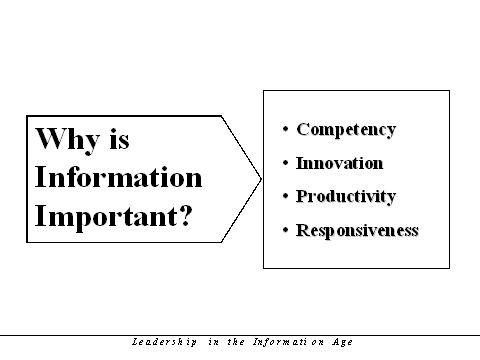|

Abstract:
This presentation highlights the vital connection between good information and strong leadership in advancing sustainable development. The six-slide presentation explores key concepts such as originality in leadership, identifying and addressing information gaps, managing information through its transformation from raw data to knowledge, and adding value to information for effective decision-making.
It underscores the importance of multi-skills in using information across different levels, purposes and technologies. By equipping leaders to handle information competently, the presentation emphasizes how informed and imaginative leadership can contribute to achieving sustainable environmental goals.
Keywords:
environmental leadership, information management, sustainable development, information gaps, decision-making, knowledge transformation, value-adding, multi-skills
|
 |
Hari Srinivas |
|
Policy Analysis Series E-087. May 2015.
|
|
Leadership in the information age requires a shift in mindset, moving from command-and-control to collaboration and empowerment. Leaders must embrace digital literacy, data-driven decision-making, and the ability to navigate a rapidly evolving technological landscape. Effective leaders also need to foster a culture of continuous learning, adapt to changing circumstances, and prioritize employee well-being.
|
Thise presentation was developed for a seminar aimed at student members of the Inter-University Environmental Forum. Organized by the United Nations University in Tokyo in June 2000, this seminar explored how effective environmental leadership is shaped and strengthened by the use of information.
The six slides in this presentation outline key ideas on the qualities of leadership in today's information-driven world, the importance of managing and adding value to information, and the challenges posed by gaps, lacks and mismatches in information. Each slide is supported by short notes that expand on these concepts and highlight their relevance for decision-making and problem-solving in environmental contexts.
This presentation emphasizes that environmental leadership today goes beyond simply accessing information. It requires originality, critical analysis, creativity, and the ability to work across multiple levels, purposes and technologies. By understanding the dynamics of information gaps, managing information effectively, and adding value through contextualization and analysis, leaders can enhance their ability to make informed decisions and drive positive environmental change.
The ideas shared in these slides aim to inspire students to think deeply about the role of information in leadership and to build the multi-skills necessary to address complex environmental challenges.
|
1. Leadership in the information age |
|

Notes
One of the key attributes of a 'leader' in the Information Age is to be original and different. Originality depends on a number of factors - being able to communicate effectively, being able to do an in-depth analysis of a situation, being able to pass judgement in a fair manner, being creative, and ambitious/visionary, and have a high propensity for imagination.
|
|
2. Finding the Information Gaps |
|

Notes
An impediment in using information effectively is the four kinds of information gaps: information you know you have; information you know you don't have; information you don't know you have; and information you don't know you don't have.
This matrix has implications for access to information, identifying information sources, packaging and disseminating information. Many problems we currently face, particularly in the decision-making processes, can be traced back to the existence of such information gaps, leading to lopsided or inadequate decisions.
Besides information "gaps", are there information "lacks" - info that is not there; and "mistatches" - info that is not right? These three - lacks, gaps and mistaches - always go together in terms of information dissemination
|
|
3. Importance of Information |
|

Notes
But why is information important? How does it affect the qualities of a leader? The right information, at the right time and at the right scale, is important to be competent; to be innovative, to be productive and to respond to different situations effectively.
Pertinent and timely information is therefore important for
- Competency - is having the necessary capacity and capabilities to carry out an activity or a job.
- Innovative - is being able to make changes, attempt new and better ideas/solutions.
- Productive - is being able to maximize output for a given set of resources.
- Responsive - is being able to effectively respond to needs and wants.
|
|
4. Information Management Pyramind |
|

Notes
This calls for proper management of information - from its collection, organization and summarization to analysis and synthesis - so that proper decision-making can take place. The position of these management steps within the continuum of data-information knowledge should also be clearly understood.
The above steps of collecting, organizing, summarizing, analyzing, synthesizing, and taking decisions, are steps in adding value to raw data, which becomes useable information, and finally knowledge at the top of the pyramid
|
|
5. Information value-adding |
|

Notes
Value-adding to a block of information is an important skill in being able to foster leadership. For example, value-adding to information on a situation or scenario involves several steps, including clarification of the context within which the information exists; providing further and in-depth details; explaining the causes and effects of the situation; developing alternatives available and outlining comparative situations; pointing out the limitations and 'warnings' of the data presented; and forecasting future prospects for the situation.
Value-adding to information has several advantages - enabling effective decision-making, maintaining a continuity in the information management processes and better knowledge transfer. |
|
6. More than just information |
|

Notes
Leadership in the information age requires a number of 'multi'-skills:
- being able to effectively use multi-media - different means and technologies; being able to adequately function at multi-levels - from local, regional to national global;
- being able to utilize information for multi-purposes - using info for different purposes, to answer queries, to generate awareness, to facilitate informed consent etc.;
- being able to initiate multi-activities - initiate formal and informal activities, facilitate interaction and integration of activities; and
- being able to scale to multi-dimensions - information dissemination on a one-to-one, one-to-many, many-to-one and many-to-many modes.
|
In today's world, where environmental challenges are increasingly complex and interconnected, good information forms the backbone of strong leadership for sustainable development. Leaders who are able to access, manage, and add value to information can make decisions that are timely, fair, and effective. Understanding and addressing information gaps, lacks and mismatches is critical in avoiding flawed or lopsided decisions. By transforming raw data into usable knowledge through systematic collection, analysis, and synthesis, leaders can ensure that their actions are grounded in evidence and geared toward long-term solutions.
Strong leadership in the information age is not only about possessing knowledge but also about applying it creatively and responsibly for the greater good. Sustainable development demands leaders who can work across multiple levels, functions and dimensions, using information to foster innovation, productivity, responsiveness and inclusiveness. By mastering the skills of information management and value-adding, environmental leaders can guide communities, organizations and societies toward a more sustainable and resilient future.
Please send any comments and suggestions to Hari Srinivas at hsrinivas@gdrc.org
|
 Hari Srinivas - hsrinivas@gdrc.org
Hari Srinivas - hsrinivas@gdrc.org






